前言
本文在前人博客的基础上做了修改和整合,用以记录IDEA创建springBoot项目整合Mybatis以及mybatisGenerator工具的使用过程。
IDEA连接mysql,原文连接:参考博客1
springBoot项目整合Mybatis,原文链接:参考博客2
MybatisGenerator工具的使用,原文链接:参考博客3
一、创建springboot项目
1.创建springboot项目
点击菜单栏 File _> new project ,进入如下页面,参照图片设置好后,点击next

2.添加依赖
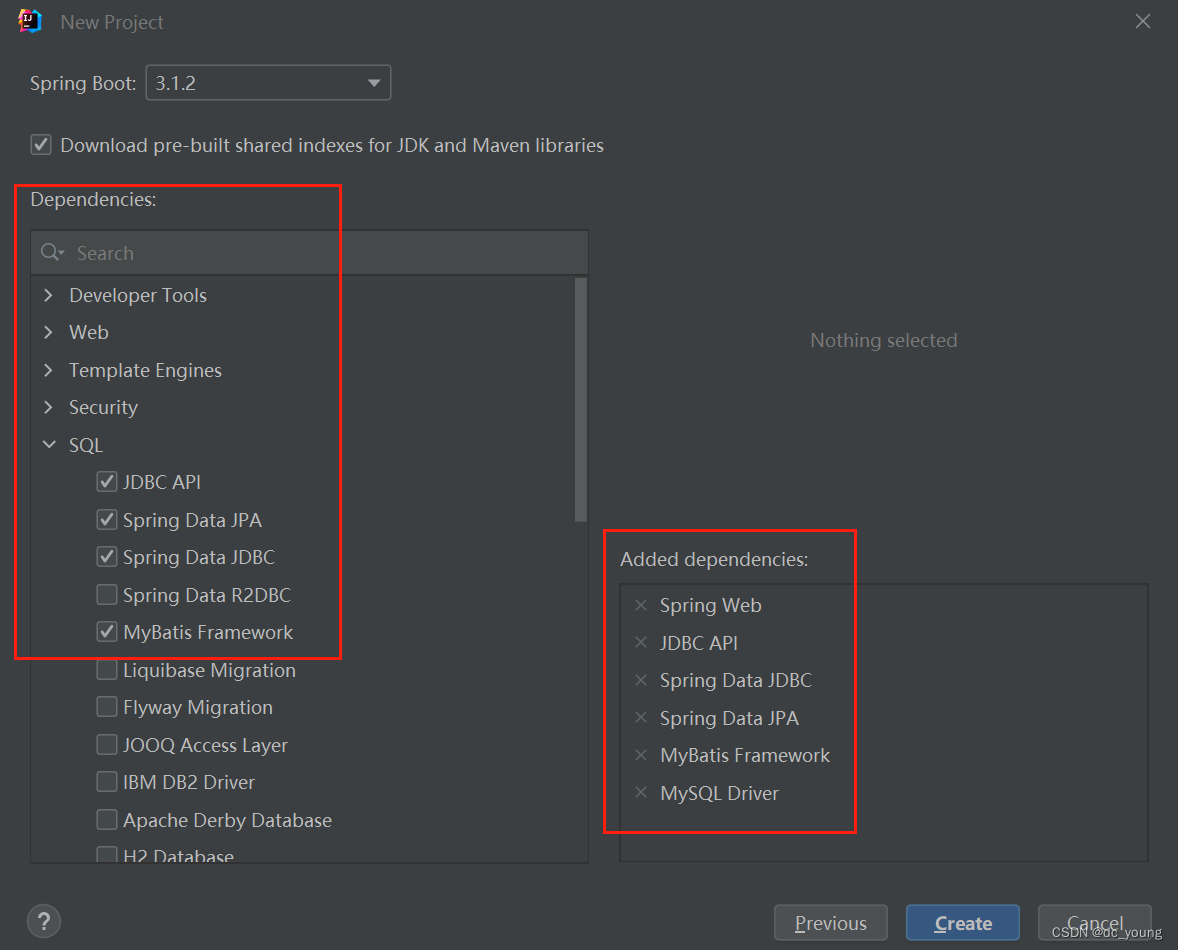
二、连接数据库
3.配置数据库连接
3.1cmd命令创建数据库:
进入cmd,输入如下命令:
mysql -u root -p
再输入密码登录mysql
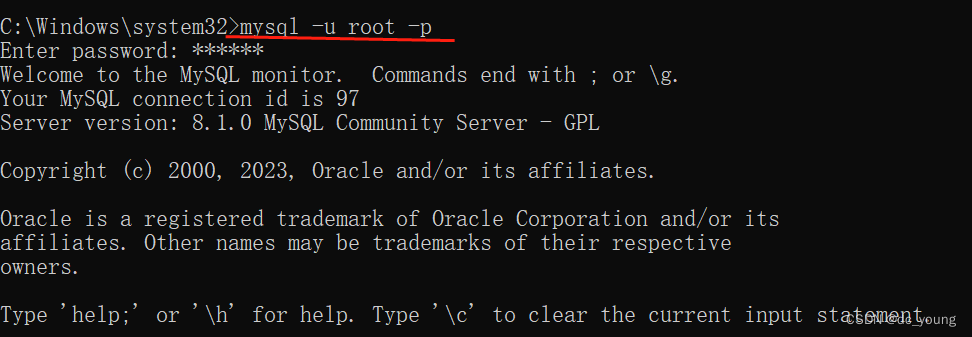
创建数据库命令
create database databaseTest2;

3.2 IDEA连接mysql
可参考:https://blog.csdn.net/dc_young/article/details/132141166
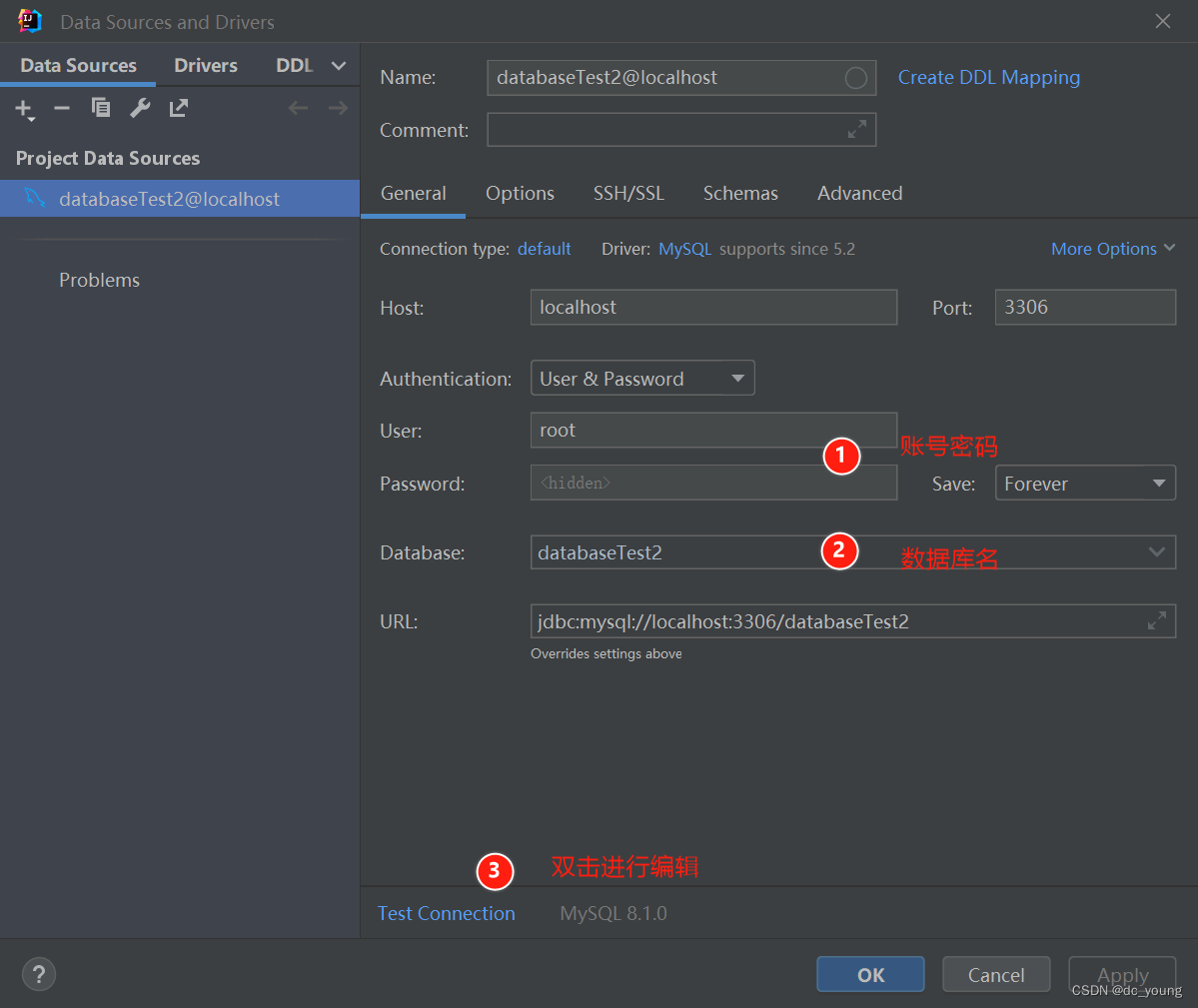
4.连接数据库,创建用户表
数据库连接成功后,右键点击数据库名,新建Query console窗口,创建用户表,用于后续测试mybatis是否配置成功

use databaseTest2;
#创建表
create table Users(
uid int not null auto_increment primary key,
uname varchar(10) not null,
uage int not null
);
#插入数据
insert into Users(uid,uname,uage) values(null,'张三',20),(null,'李四',18);
5.项目结构
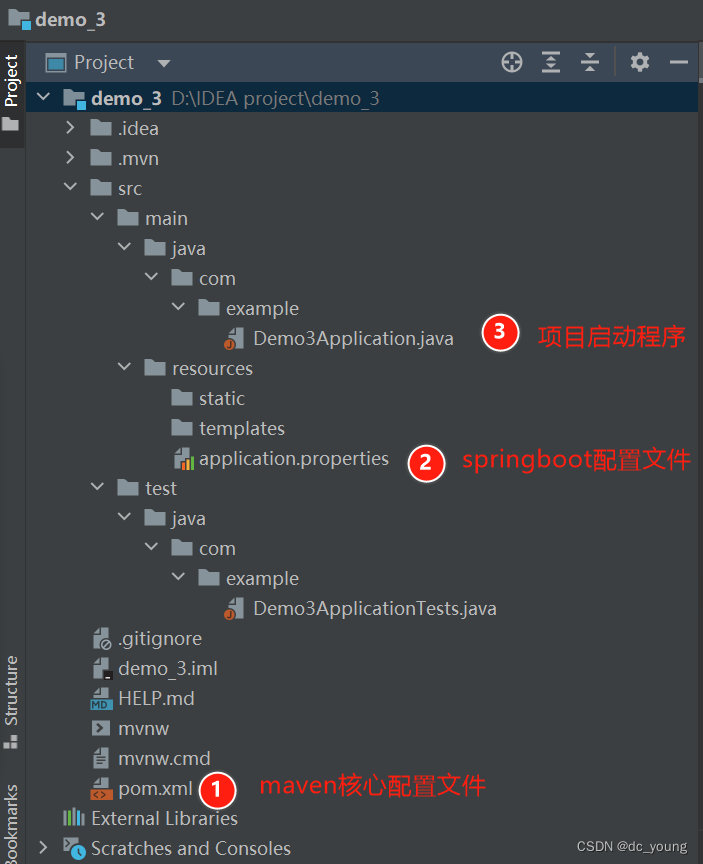
注意:项目不是maven项目?
问题:新建Springboot主程序的入口没有启动按钮
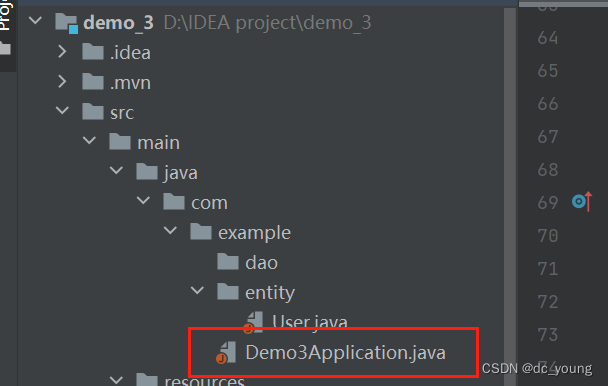
原因:
上图的启动程序没有启动按钮,因为不是maven项目(可能是因为没有关闭省电模式),依赖未导入。正确的maven项目应该是下图这样的
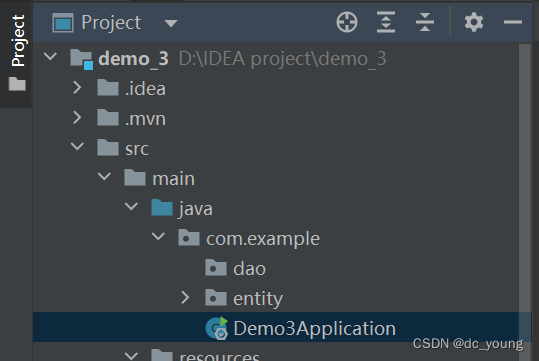
解决办法
变Maven项目
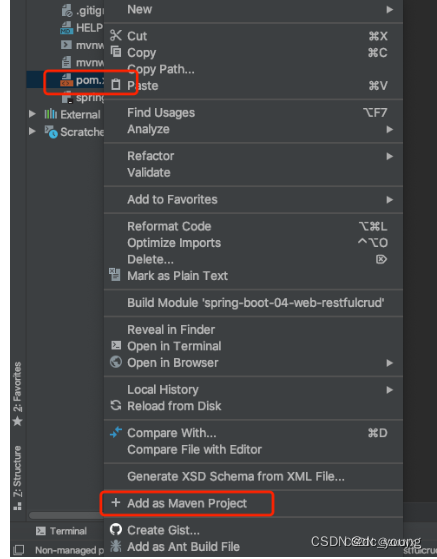
关闭省电模式
6.引入相关依赖
在dependencies上一行引入相关依赖

<dependency>
<groupId>org.mybatis</groupId>
<artifactId>mybatis</artifactId>
<version>3.5.2</version>
</dependency>
<dependency>
<groupId>mysql</groupId>
<artifactId>mysql-connector-java</artifactId>
<version>8.0.11</version>
</dependency>
<dependency>
<groupId>junit</groupId>
<artifactId>junit</artifactId>
<version>4.12</version>
<scope>compile</scope>
</dependency>
在build下一行引入相关资源路径
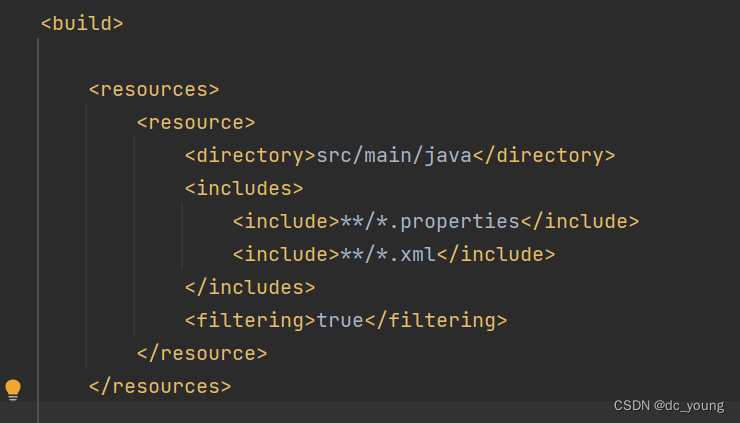
<resources>
<resource>
<directory>src/main/java</directory>
<includes>
<include>**/*.properties</include>
<include>**/*.xml</include>
</includes>
<filtering>true</filtering>
</resource>
</resources>
7.数据库配置文件
在java/resources下创建db.properties文件
mysql.driver=com.mysql.cj.jdbc.Driver
mysql.username=root
mysql.password=123456
mysql.url=jdbc:mysql://localhost:3306/databaseTest2?serverTimezone=UTC&characterEncoding=utf8&useUnicode=true&useSSL=false

三、配置Mybatis
8.mybatis配置文件
在java/resources下创建MybatisConfig.xml文件

<?xml version="1.0" encoding="UTF-8" ?>
<!DOCTYPE configuration
PUBLIC "-//mybatis.org//DTD Config 3.0//EN"
"http://mybatis.org/dtd/mybatis-3-config.dtd">
<configuration>
<properties resource="db.properties"/>
<environments default="development">
<environment id="development">
<transactionManager type="JDBC"/>
<dataSource type="POOLED">
<!-- JDBC 驱动-->
<property name="driver" value="${mysql.driver}"/>
<!-- url数据库的 JDBC URL地址。-->
<property name="url" value="${mysql.url}"/>
<property name="username" value="${mysql.username}"/>
<property name="password" value="${mysql.password}"/>
</dataSource>
</environment>
</environments>
</configuration>
9.创建空文件夹
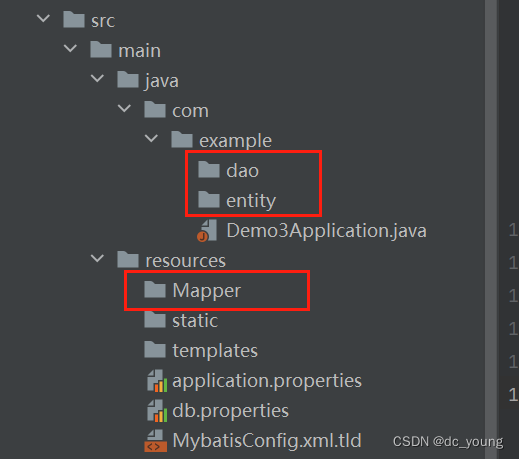
10.创建实体类
entity 包下的 User 类,用于封装 User 对象的属性
package com.example.entity;
public class User {
private int uid;
private String uname;
private int uage;
public int getUid() {
return uid;
}
public void setUid(int uid) {
this.uid = uid;
}
public String getUname() {
return uname;
}
public void setUname(String uname) {
this.uname = uname;
}
public int getUage() {
return uage;
}
public void setUage(int uage) {
this.uage = uage;
}
}
11.创建映射文件
Mapper 文件夹下的 UserMapper.xml 文件(即映射文件)。
注意配置实体类路径:namespace参数和resultType参数

<!DOCTYPE mapper
PUBLIC "-//mybatis.org//DTD mapper 3.0//EN"
"http://mybatis.org/dtd/mybatis-3-mapper.dtd">
<mapper namespace="com.example.entity.User">
<select id="findById" parameterType="int" resultType="com.example.entity.User">
select * from users where uid = #{id}
</select>
</mapper>
12.创建mapper映射模板文件
每次新建一个实体类就要创建一个映射文件,由于创建映射文件不会提供头部声明,复制粘贴起来也很麻烦,所以这里我们可以通过创建一个映射文件模板的方式,新建映射文件。(当然不影响本项目,你可以不创建,只不过为了方便)
具体步骤,File → Settings → Editor → File and Code Templates → 加号
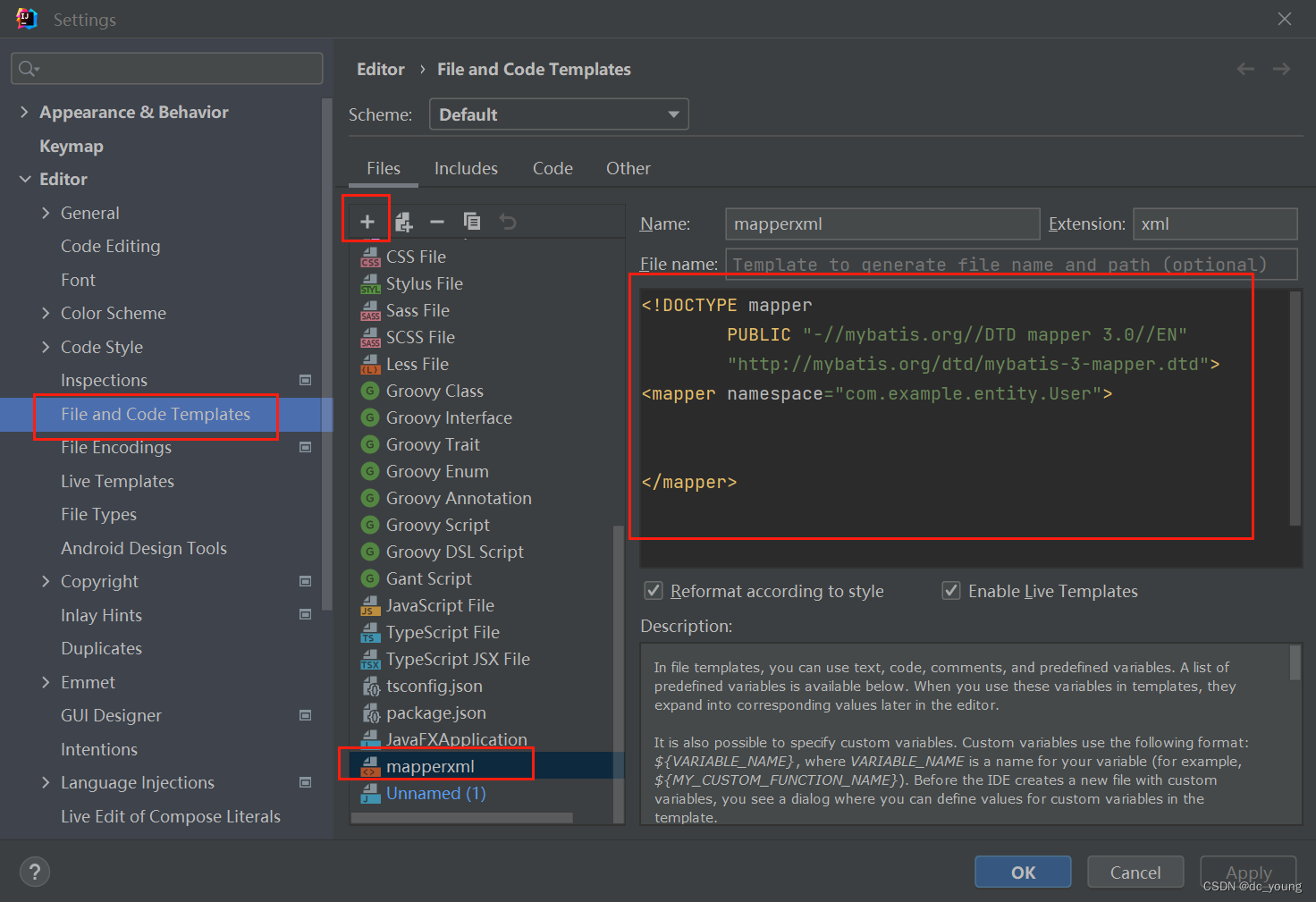
复制我的代码进去:
<!DOCTYPE mapper
PUBLIC "-//mybatis.org//DTD mapper 3.0//EN"
"http://mybatis.org/dtd/mybatis-3-mapper.dtd">
<mapper namespace="com.example.entity.User">
</mapper>
别忘了 Apply,下次需要可直接在选项卡中看到 mapperxml!
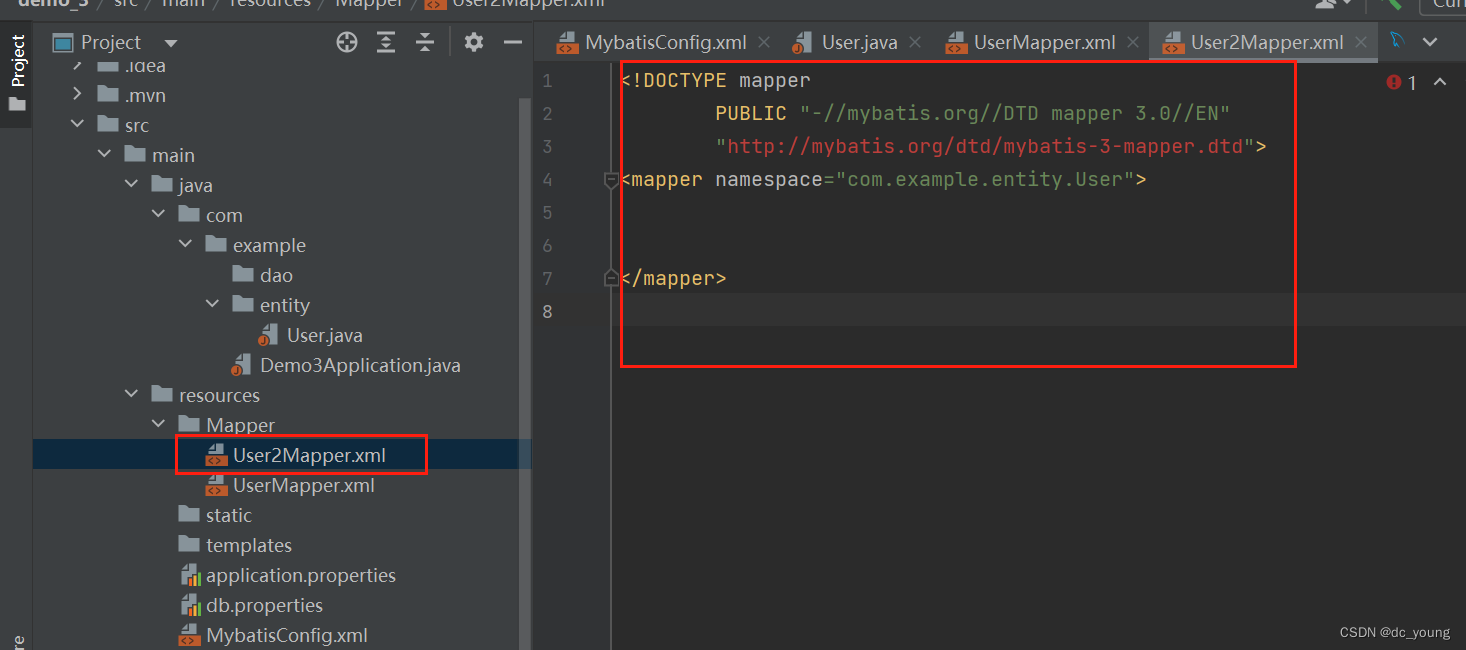
13.修改mybatis配置文件
将映射文件的路径添加到 mybatis配置文件中
(将UserMapper.xml 的路径添加到 MybatisConfig.xml 中)
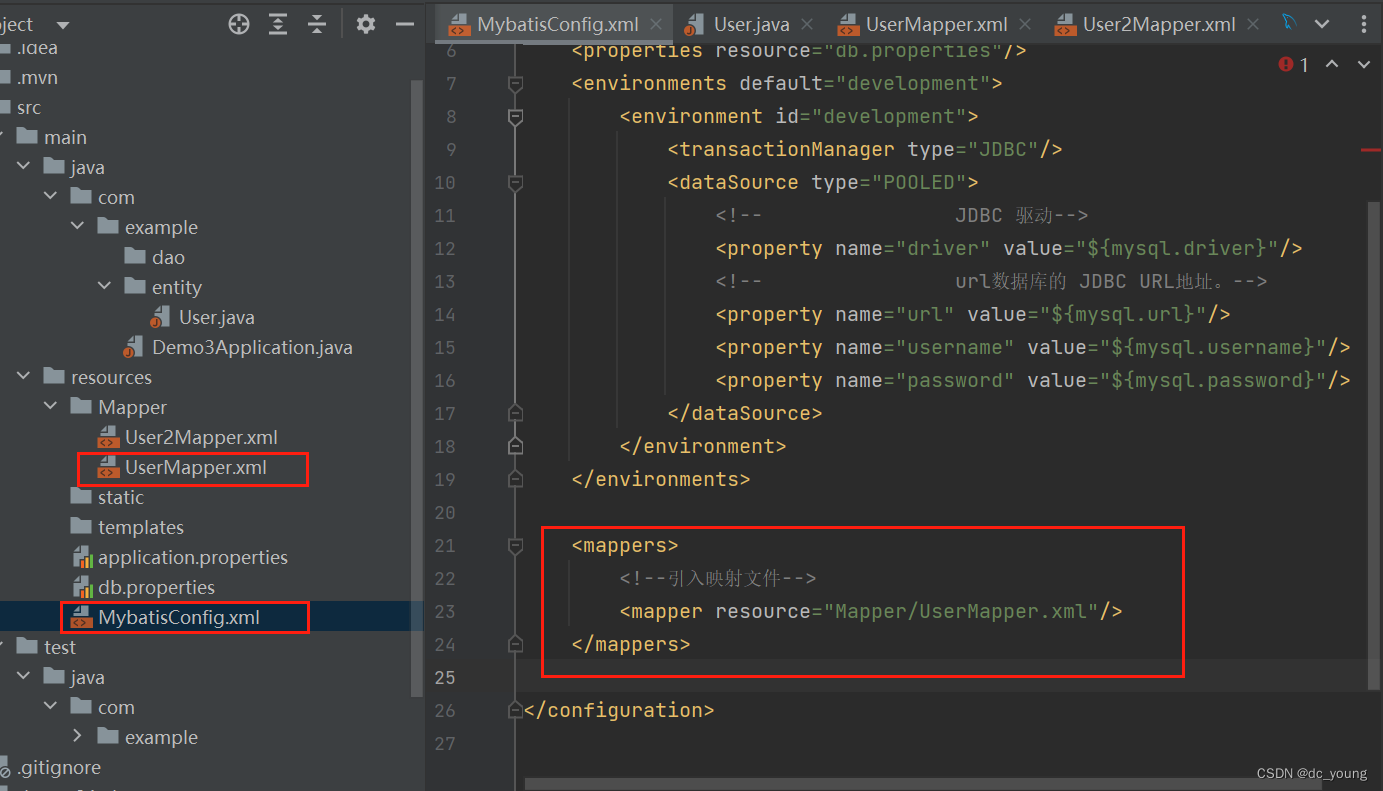
<mappers>
<!--引入映射文件-->
<mapper resource="Mapper/UserMapper.xml"/>
</mappers>
继续打开我们前面已经创建好的 MybatisConfig.xml 文件,现在我们给它配置文件路径,至于刚刚为什么没有配置,是因为这个路径就是映射文件所在的位置,所以我们先把映射文件编写完再返回来给 MybatisConfig.xml 设置路径。
14.编写测试类
注意:如果报错:Could not find resource MybatisConfig.xml
问题:测试类启动,报错:Could not find resource MybatisConfig.xml
原因:
1.resources文件夹下 没有MybatisConfig.xml文件(MybatisConfig.xml文件路径不对)
2.resources文件夹没有被标记为资源根目录
解决:
1.MybatisConfig.xml文件放到resources文件夹下
2.如果MybatisConfig.xml文件已经resources文件夹下,且resources文件夹没有如图黄色块标识(资源根目录标识),则将其添加为资源根目录。 
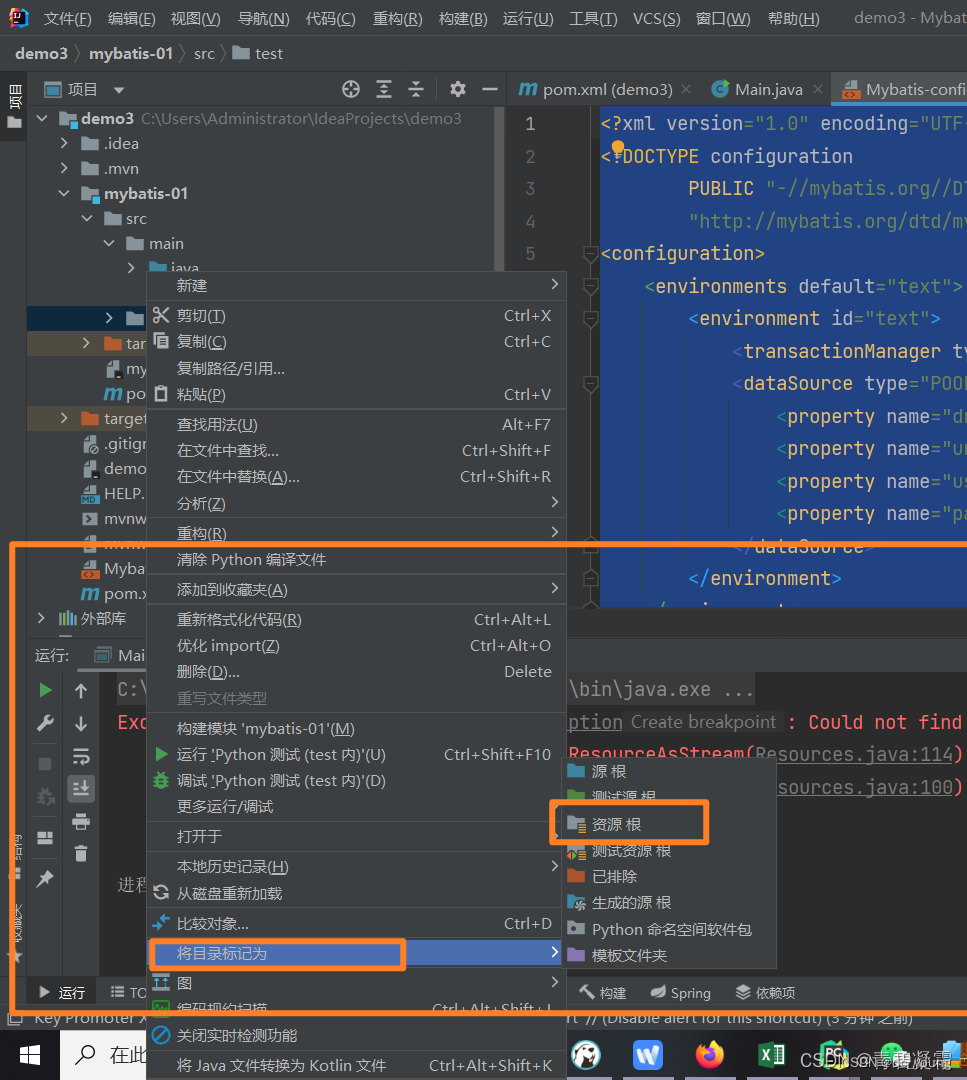
四、使用MybatisGenerator工具
(一)、MyBatis Generator 简介
官网的MyBatis Generator使用介绍,请点击下面的链接:
链接
MyBatis Generator 生成的文件包含三类:
(1)Model实体文件,一个数据库表对应生成一个 Model 实体;
(2)Mapper接口文件,数据数操作方法都在此接口中定义;
(3)Mapper XML配置文件
(二)、使用步骤
1.引入MyBatis Generator相关依赖
在pom.xml文件添加如下依赖:
<dependency>
<groupId>org.mybatis.generator</groupId>
<artifactId>mybatis-generator-core</artifactId>
<version>1.3.7</version>
</dependency>
2.配置MybatisGeneratorConfig.xml文件
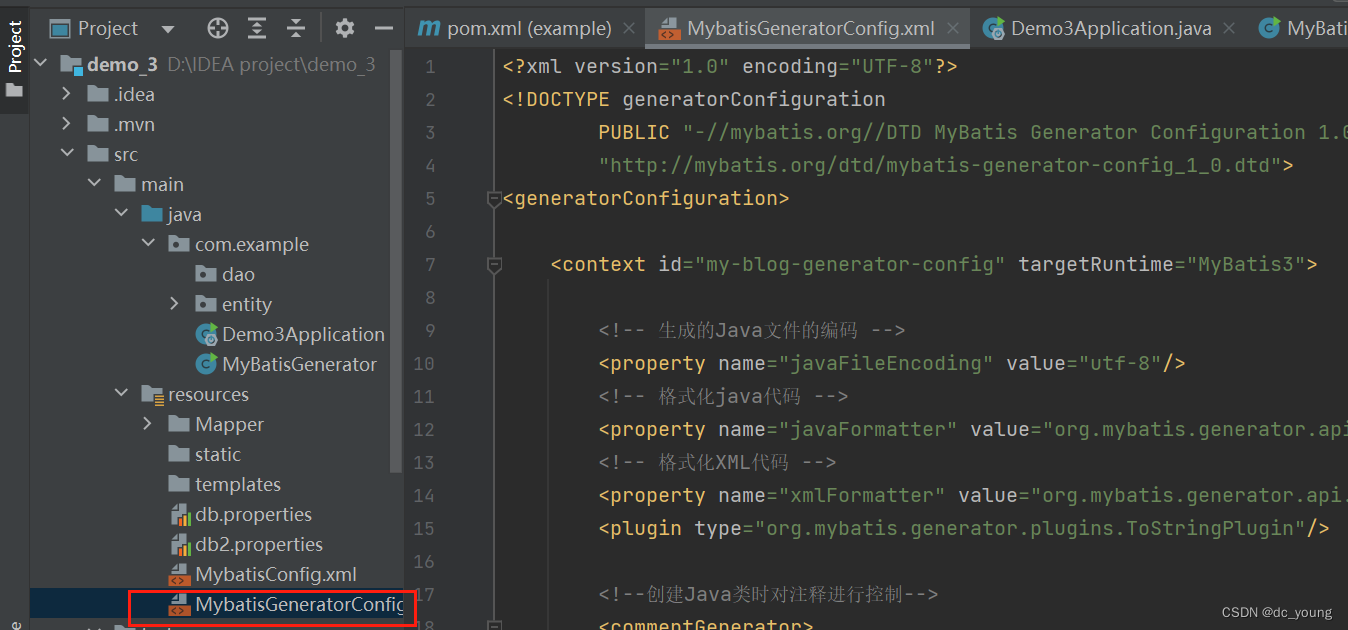
代码如下(示例):
<?xml version="1.0" encoding="UTF-8"?>
<!DOCTYPE generatorConfiguration
PUBLIC "-//mybatis.org//DTD MyBatis Generator Configuration 1.0//EN"
"http://mybatis.org/dtd/mybatis-generator-config_1_0.dtd">
<generatorConfiguration>
<context id="my-blog-generator-config" targetRuntime="MyBatis3">
<!-- 生成的Java文件的编码 -->
<property name="javaFileEncoding" value="utf-8"/>
<!-- 格式化java代码 -->
<property name="javaFormatter" value="org.mybatis.generator.api.dom.DefaultJavaFormatter"/>
<!-- 格式化XML代码 -->
<property name="xmlFormatter" value="org.mybatis.generator.api.dom.DefaultXmlFormatter"/>
<plugin type="org.mybatis.generator.plugins.ToStringPlugin"/>
<!--创建Java类时对注释进行控制-->
<commentGenerator>
<property name="suppressDate" value="true"/>
<!-- 是否去除自动生成的注释 true:是 : false:否 -->
<property name="suppressAllComments" value="true"/>
</commentGenerator>
<!--数据库地址及登陆账号密码 改成你自己的配置-->
<jdbcConnection
driverClass="com.mysql.cj.jdbc.Driver"
connectionURL="jdbc:mysql://localhost:3306/databaseTest2"
userId="root"
password="123456">
</jdbcConnection>
<javaTypeResolver>
<property name="forceBigDecimals" value="false"/>
</javaTypeResolver>
<!--生成实体类设置,改成你自己的配置,注意修改targetPackage参数和targetProject参数-->
<javaModelGenerator targetPackage="com.example.entity" targetProject="src/main/java">
<property name="enableSubPackages" value="true"/>
<property name="trimStrings" value="true"/>
</javaModelGenerator>
<!--生成Mapper文件设置,改成你自己的配置,注意修改targetPackage参数和targetProject参数-->
<sqlMapGenerator targetPackage="Mapper" targetProject="src/main/resources">
<property name="enableSubPackages" value="true"/>
</sqlMapGenerator>
<!--生成Dao类设置,改成你自己的配置,注意修改targetPackage参数和targetProject参数-->
<javaClientGenerator type="XMLMAPPER" targetPackage="com.example.dao"
targetProject="src/main/java">
<property name="enableSubPackages" value="true"/>
</javaClientGenerator>
<!--需要自动生成代码的表及对应的类名设置-->
<!-- <table tableName="generator_test" domainObjectName="GeneratorTest"-->
<!-- enableCountByExample="false"-->
<!-- enableUpdateByExample="false"-->
<!-- enableDeleteByExample="false" enableSelectByExample="false" selectByExampleQueryId="false">-->
<!-- </table>-->
<!--配置数据库表名tableName和实体类名domainObjectName,改成你自己的配置-->
<table tableName="users2" domainObjectName="User2"
enableCountByExample="false"
enableUpdateByExample="false"
enableDeleteByExample="false" enableSelectByExample="false" selectByExampleQueryId="false">
</table>
</context>
</generatorConfiguration>
3.创建MyBatisGenerator类
在src/main/java/com/example/下创建util文件夹,并在util下创建MyBatisGenerator类

MyBatisGenerator.java 代码如下
package com.example;
import org.mybatis.generator.config.Configuration;
import org.mybatis.generator.config.xml.ConfigurationParser;
import org.mybatis.generator.internal.DefaultShellCallback;
import java.io.InputStream;
import java.util.ArrayList;
import java.util.List;
public class MyBatisGenerator {
public static void main(String[] args) throws Exception {
//MBG 执行过程中的警告信息
List<String> warnings = new ArrayList<String>();
//当生成的代码重复时,覆盖原代码
boolean overwrite = true;
//读取我们的 MBG 配置文件
InputStream is = MyBatisGenerator.class.getResourceAsStream("/MybatisGeneratorConfig.xml");
ConfigurationParser cp = new ConfigurationParser(warnings);
Configuration config = cp.parseConfiguration(is);
is.close();
DefaultShellCallback callback = new DefaultShellCallback(overwrite);
//创建 MBG
org.mybatis.generator.api.MyBatisGenerator myBatisGenerator = new org.mybatis.generator.api.MyBatisGenerator(config, callback, warnings);
//执行生成代码
myBatisGenerator.generate(null);
//输出警告信息
for(String warning : warnings){
System.out.println(warning);
}
}
}
执行代码,然后刷新目录就可以看到生成的类以及xml了 。
4.注意:
1.如果代码执行失败,且报错如下:
org.apache.ibatis.exceptions.PersistenceException :
### Error building SqlSession.
### The error may exist in com/erp/webservice/mapper/UsersMapper.xml
### The error occurred while processing mapper_resultMap[BaseResultMap]
···
原因:运行了多次自动生成代码的程序,导致了resources/Mapper/Users2Mapper.xml 的内容多出来很多,原来自动生成代码的时候生成的XML代码不是覆盖原来的,而是附加的XML的尾部的。
解决办法:
只要删掉原来的Users2Mapper.XML,然后重新运行自动生成代码的程序即可。
2.如果代码执行成功,但项目目录没有看到申城的类和xml,可能是IDEA没有自动更新目录,需手动更新。
更新目录方式:
1.更新整个项目目录:左上角菜单栏file -> Reload ALL from Disk
2.更新指定文件夹目录:右键指定文件夹 -> Reload from Disk
(三)、测试
1.数据库建表
在src/main下创建文件夹sql,在sql文件夹下创建mysqlCode.sql文件,并复制如下sql代码
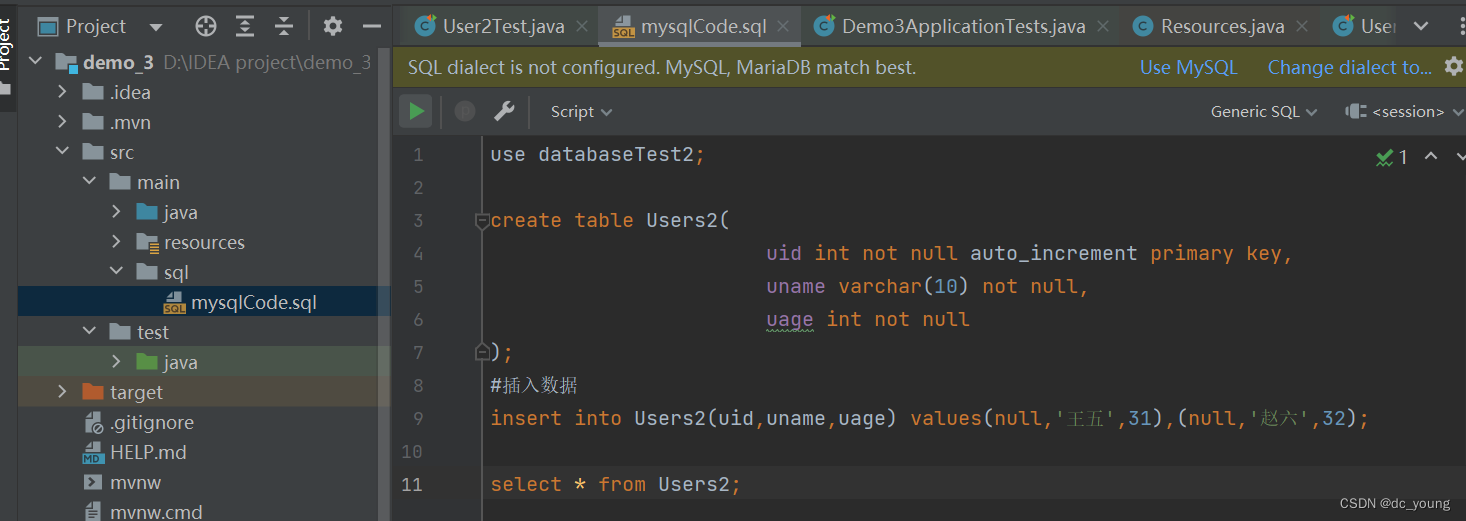
use databaseTest2;
create table Users2(
uid int not null auto_increment primary key,
uname varchar(10) not null,
uage int not null
);
#插入数据
insert into Users2(uid,uname,uage) values(null,'王五',31),(null,'赵六',32);
select * from Users2;
点击“use MySQL”
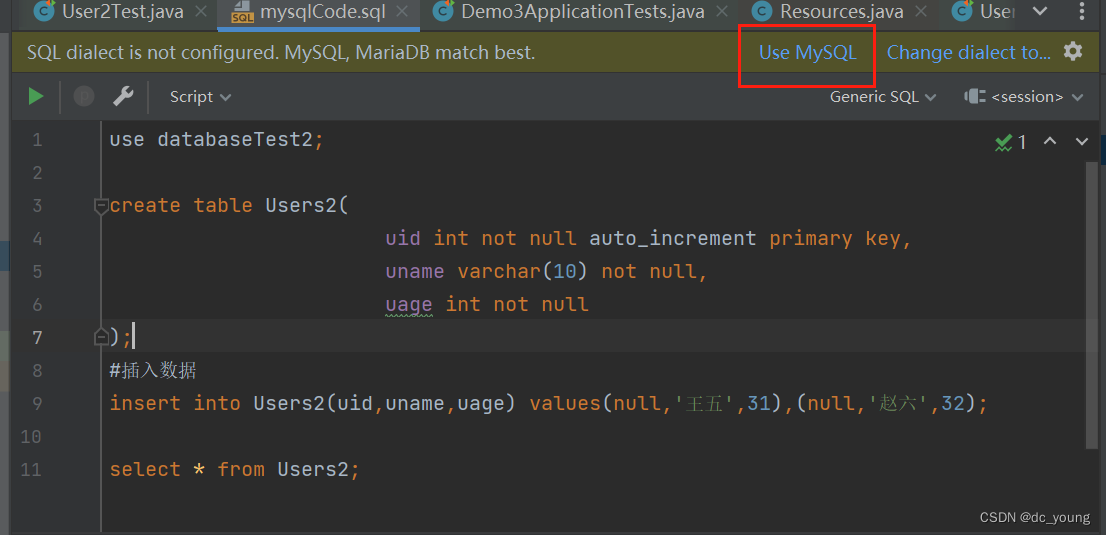
执行上述sql代码,创建用户表,用于后续测试MybatisGenerator工具是否配置成功
2.修改MybatisConfig.xml配置文件,添加新的映射文件声明

<!--引入映射文件-->
<mapper resource="Mapper/User2Mapper.xml"/>
3.编写测试类
在src/test/java路径下创建 User2Test.java文件
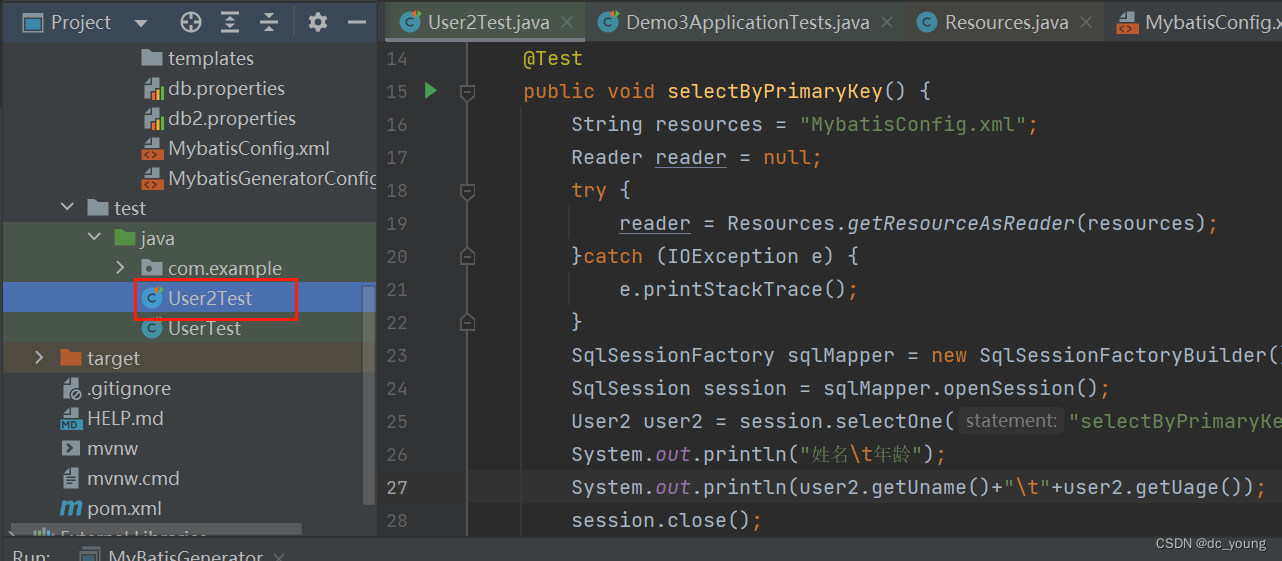
import com.example.entity.User2;
import org.apache.ibatis.io.Resources;
import org.apache.ibatis.session.SqlSession;
import org.apache.ibatis.session.SqlSessionFactory;
import org.apache.ibatis.session.SqlSessionFactoryBuilder;
import org.junit.Test;
import java.io.IOException;
import java.io.Reader;
public class User2Test {
@Test
public void selectByPrimaryKey() {
String resources = "MybatisConfig.xml";
Reader reader = null;
try {
reader = Resources.getResourceAsReader(resources);
}catch (IOException e) {
e.printStackTrace();
}
SqlSessionFactory sqlMapper = new SqlSessionFactoryBuilder().build(reader);
SqlSession session = sqlMapper.openSession();
User2 user2 = session.selectOne("selectByPrimaryKey",1);
System.out.println("姓名\t年龄");
System.out.println(user2.getUname()+"\t"+user2.getUage());
session.close();
}
}
执行测试类,查询出如下数据说明 MybatisGenerator工具配置成功
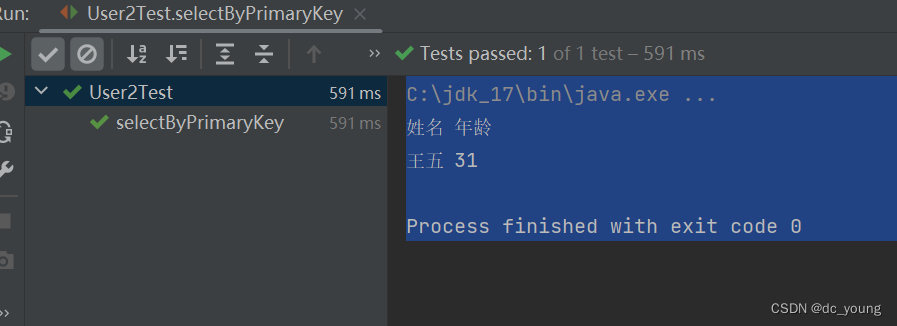








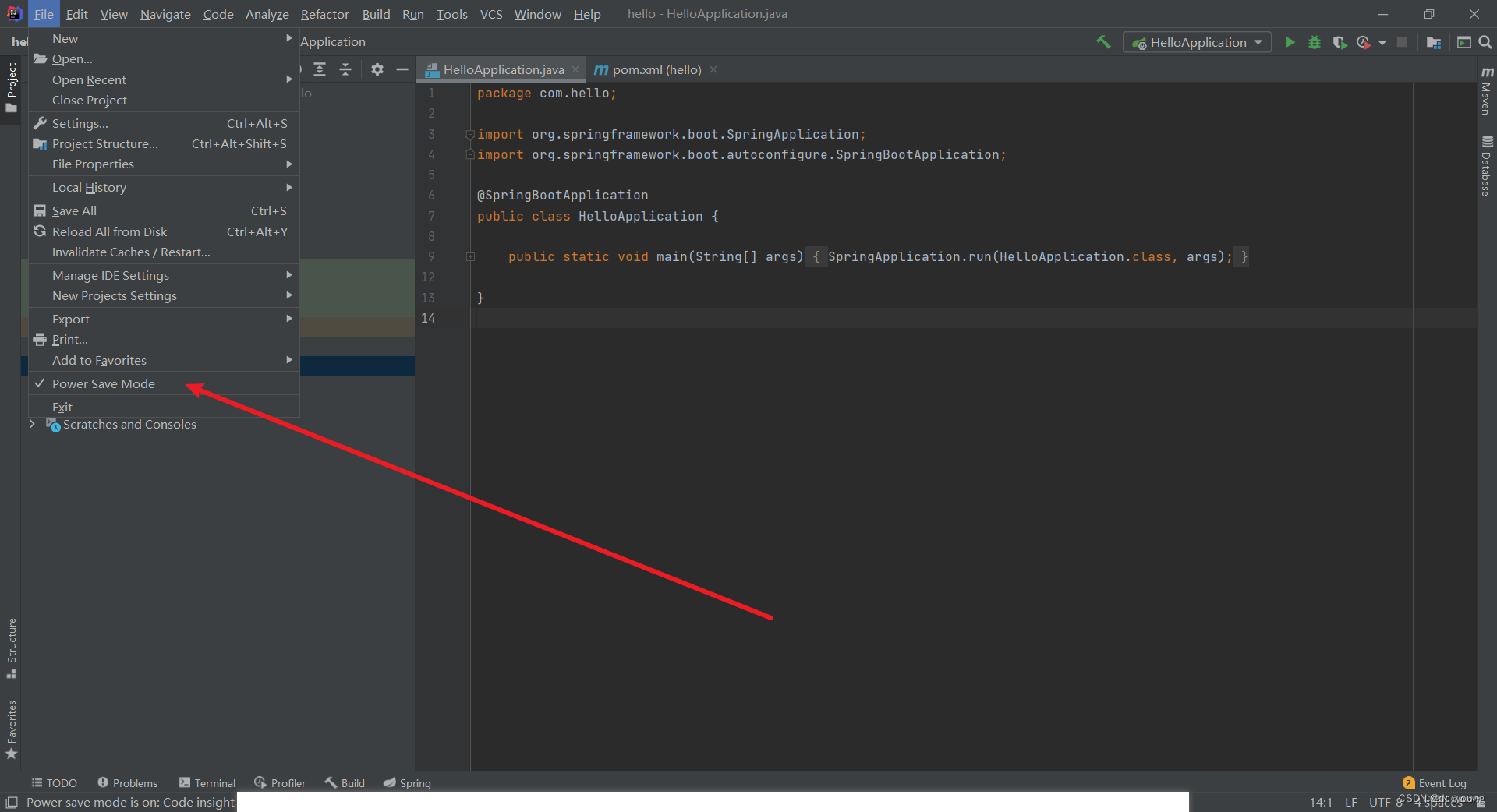














 647
647











 被折叠的 条评论
为什么被折叠?
被折叠的 条评论
为什么被折叠?








